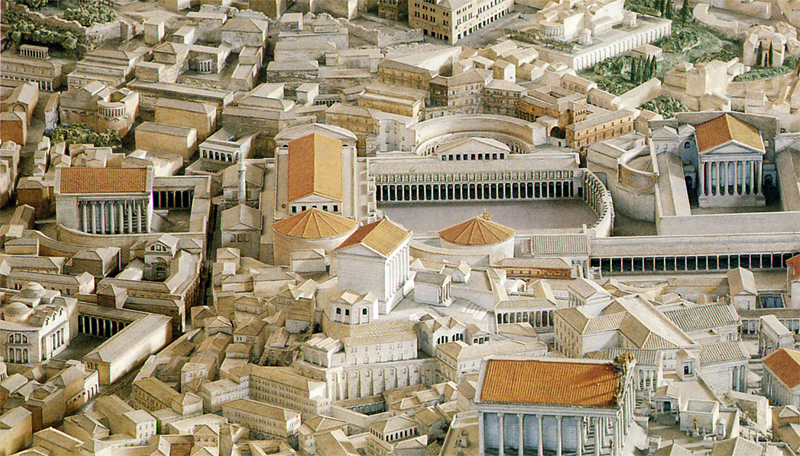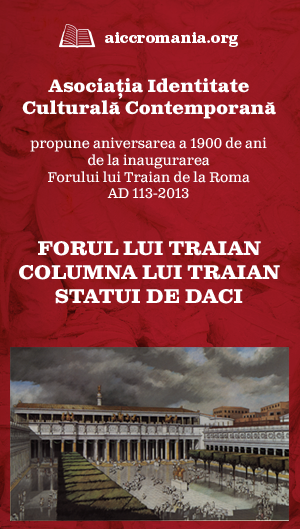Much of these statues representing Dacians were made after the wars between the Romans and Dacians (from 101 to 106 AD) in order to be placed in the Forum of Trajan in Rome. The archaeological excavations conducted in the Forum of Trajan (Rome) in the years 1998-2000 brought to light another three sculptures of Dacians, out of which two headless statues and a head.







As the reconstitutions of the Forum of Trajan show, the statues of Dacians were placed at height, above each column that supported the galleries of porticos and the facade of the Basilica Ulpia. A first "problem" would be that the height of these statues of Dacians, found until today, vary widely among themselves, which fact can not be admitted from an aesthetical point of view. According to the reconstitutions made by the specialists of the Forum of Trajan, these statues would have been part in a well defined architectural framework, they representing caryatids. Thus, the height of these sculptures would have to be, necessarily, just the same for all these statues. This is not at all the case: their height varies much from one statue to another. Starting from the idea that the height measurements were carried out with sufficient precision, the statues mentioned above could be classified into three categories:
- those with a height of 2.60 m,
- those with a height of 3.00 m,
- the remaining states, with quite heterogeneous heights that can be contained in a range of 2.25 to 2.53 m and 3.15 to 3.24 m.


According to the reconstitutions of the Forum of Trajan, statues of the first two categories can be considered that would have been part of the Forum, entered into a well defined architectural element, James E. Packer, who has done in 1972 the graphic reconstitution of the Forum of Trajan, actually gives the average height of these statues of Dacians in the Forum, indicating the following dimensions:
- 2.682 meters (for the porticos colonnade),
- 3.084 m (for Basilica Ulpia)
And the representation of the statues of Dacians from the third category can not qualify, in Trajan's Forum complex, in the group of "caryatids", because of their height diversity, as well as from the aesthetic point of view. Presumably the statues in this category made part, however, of Trajan's Forum, and were created in the period of Trajan, and at different times, but the exact place that they occupied is not known. Another hypothesis would be: these images just come from another place, totally different from the Forum of Trajan. Among the known sculptures of Dacians, most of them were found in this Forum following archeological excavations, others (not all) have been found in private collections and it is supposed that they would come from the Forum of Trajan, as well. Currently, these sculptures are exhibited in the Forum of Trajan Museum, many pieces are in the reserves of this Forum, as well as in other state and private collections throughout the world.
According to the classic, traditional plan of the Forum of Trajan, the number of columns of porticos being lower, the number of statues of Dacians appear also lower, above each column, as it can be seen on the graphic reconstructions. But after the development of the new plan of the Forum of Trajan, as a result of the recent archeological excavations, the number of columns supporting the porticoes is higher, and so the number of statues of Dacians is higher:
- Southeast facade of the Basilica Ulpia: 16 + 2 statues of Dacians (those assumed to be placed in the corners, for aesthetic reasons);
- Attic of the northeastern portico (internal facade): 25 statues of Dacians + 2 more statues in the corners;
- South-eastern tripartite gallery (internal facade): 20 statues in the attic to the patio;
- Attic of the southwestern portico (internal facade): 25 statues of Dacians + 2 more statues in the corners.
Total
- 86 + 6 statues of Dacians at the corners, but their existence here is discussed as being unlikely. So, 86 statues are "sure", and 92 are questionable.
+ - 5 (or 7) statues of Dacians made of cherry-red porphyry, found until today, which would proceed also from the Forum of Trajan, from the "Porticus Purpuretica" mentioned in the ancient times, an architectural space the location of which has not yet been exactly identified. How many statues of Dacians had been part of the portico of red porphyry is not known, and probably will not ever been known; in this amount is taken into account the existing number of statues of Dacians of cherry-red porphyry, which were found until now.
So, a total of about 86 (or 92) + 5 (or 7) = 91 (or 99) the statues of Dacians, in the Forum of Trajan, where their exact location is assumed to be at the attics level. And the remaining statues in size quite different from those discussed above, may not also be placed in the category of "caryatids".
From other estimates and variations, made by different authors, in terms of the number of statues of Dacians in the Forum of Trajan, the followings arise:
- on the facade of the Basilica of Trajan: 15 statues of Dacians;
- around the Forum on three sides, at the attic of the porticos: 60 statues of Dacians;
- So, a total of 75 statues of Dacians;
- according to other hypotheses a total of 82 statues of Dacians in the Forum of Trajan.
În urma descoperirilor arheologice și reconstituirilor arhitecturale, reseie faptul că acest For a fost cel mai mare For din Imperiul Roman, cel mai majestuos și cel mai costisitor, unde au fost folosite cele mai prețioase materiale de construcție.
The archaeological discoveries and architectural reconstructions show the fact that this Forum was the biggest of the whole Roman Empire, the most majestic and the most expensive, where the most valuable materials were used.
Dr Leonard Velcescu


















